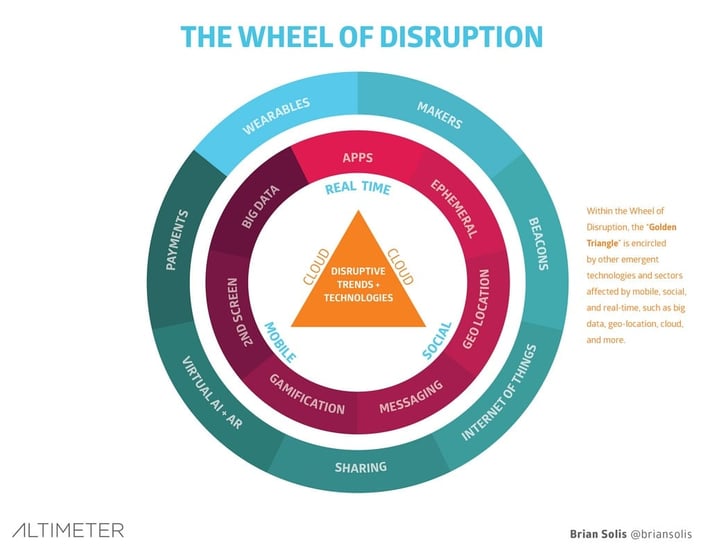What are the topmost NodeJS practices for developers?.
Node.js, a platform based on Chrome's JavaScript motor assists with growing quick, adaptable system applications. It utilizes an occasion driven,...
5 min read
Sales : Dec 13, 2017 12:00:00 AM

In this age of rapidly evolving technology, businesses need to align their activities with the changing trends and innovations. Take for instance the major buzzwords in the industry - artificial intelligence, machine learning, chatbots, automation, augmented and virtual reality, Internet of Everything (IoE) and big data analytics - accounting for all of these using the present business processes is too complicated to execute. The increasing number of consumer touchpoints due to mobile apps, social media, and online communities is another issue which business leaders need to sort.

Earlier there used to be one or a few technologies that business executives needed to focus on. Now there are so many rapidly evolving technologies that require a complete business overhaul for effective implementation. To solve this problem companies are opting for digital transformation to set their foot in the changing technology landscape. Digital Transformation is the use of technology to enhance the profitability and working of organizations by radically transforming their current operations and process.
George Westerman, Didier Bonnet, and Andrew McAfee collectively published a research paper, ‘Digital Transformation: A Roadmap for Billion-Dollar Organizations’. In their research, they interviewed 157 executives from 50 companies. These companies largely made $1 billion or more in annual sales and spanned across 15 nations. These companies were actively involved in digital transformation and had used different approaches to succeed in their initiatives. From their research, we came know about the 9 elements of digital transformation. These elements dictate the focus areas where business leaders need to work on to effectively initiate digital transformation in their organization. At NewGenApps, we have added our own insights and perspective toward each of these 9 elements to help you better understand their meaning.
Want to know more about latest technologies? Explore our library of technology resources and feel free to grab your pick.
Analysis of the report gave insights into the mindset of leading executives and thought leaders in business and technology. Based on the findings, the initiatives towards digital transformation were divided into 3 broad categories each of which were further branched into three subsets. Here we will briefly look into all of them so that you can make an informed digital transformation strategy:

Customer experience is the new battleground for brands. With every brand taking initiatives to enhance the buying experience it is necessary for enterprises to pivot from obsolete practices and use innovative technologies to stand out. The 3 major areas where companies are digitally transforming the customer experience are customer understanding, top-line growth, and customer touch points.
Large-scale companies already have tons of data which they previously left unutilized. With the advent of cloud and the relative ease in big data analysis, companies are now able to take advantage of their historical data. This analysis gives insights into the behavior and preferences of different market segments and geographies.
Along with the use of historical data, companies are also analyzing social media signals and discussions in online communities. This offers real-time insights to the companies and compliments the historical data to provide an overall view of the market.
Top line growth refers to optimizing the sales process and in-person buying experience. The major initiatives in this process include the use of mobile technologies and cloud to empower the sales representatives to effectively establish a relationship between vendor partners and the company. The other side involves improving the relationship between brand and its customers.
Companies are establishing theme stores at various physical location to offer a unique seamless buying experience. Apple, for instance, has set up Apple Store across the globe to differentiate the customer experience. By December 2017 there are already 500 stores across 22 countries worldwide. Use of geofencing to execute location-based marketing is also an effective tactic to ensure top-line growth.
Providing an omnichannel experience to customers is a major challenge faced by companies today. With social media, mobile, web and online communities all offering distinguishing information and buying experience, companies need a strategic approach towards customer relationship management.
It is common practice for companies to set up twitter accounts to address customer queries and provide support. The use of chatbots and self-help options in mobile apps are also effective ways that brands can use to provide effortless service to the customer throughout different touchpoints.
The scope of digital transformation extends beyond improving the customer experience. Enterprises can also leverage the new technologies to optimize or even alter their existing business process. This can be done in three ways:
Robotic Process Automation (RPA) is the use of artificial intelligence to automate routine activities so that the employees can focus on core functions. This is primarily done to automate rule-based tasks. Common benefits include code-free usage, easy implementation, and user-friendly environment.
RPA can be used to automate manufacturing units, internal communication, and IT support. At NewGenApps we have created an automation solution that offers three powerful tools which include repetitive process identifier (System Monitoring), robotics process automation (Business Process Automation) and Intellibot (Chatbot Builder). Watch our above video to know more.
A majority of all the tasks in an organization have been virtualized. Virtualization of tasks has allowed workers to perform their job remotely allowing for more work from home opportunities. This ensures better coordination of work and employee satisfaction.
This virtualization of work is empowered by improved communication tools that help establish better synchronization of work. It is now easier to get relevant answers from concerned persons due to improved internal communication. This has also led to a reduction in interdepartmental conflicts. Overall digital transformation is a very effective way to bridge the communication gap between the frontline executives and technical staff.
The modern management solutions offer detailed insights into both the internal functions and customer-facing operations. These intricate details offer scope for real-time data analysis. The insights gathered can help managers take an appropriate management approach based on data.
By kicking the assumptions out of the decision-making process it is easy to make appropriate decisions based on individual circumstances. In the absence of such systems, it is difficult to hold any single person, team or department responsible for an issue. It becomes difficult to solve lags in operations as the key exception is not identified.

Where transformation of processes indicates the change in working of individual departments, remodeling of business refers to the change in the method of interaction between distinct departments.
Traditional business is rapidly moving towards digital models, for instance, brick and mortar retail is shifting its focus towards eCommerce. This helps them secure new customers, retain clients and improve cross-selling. Omni-channel sales also allow the establishment of an authoritative position in the market.
While for retail the process of using digital media for new business is obvious, other businesses like food and beverages, fashion and even industrial goods manufacturers are incorporating digital mediums into their current business process. This lets them inform customers about their products and services and efficiently sell them once they enter stores or when sales reps approach them.
Companies are introducing new digital products in the market that complement their traditional products. This helps them in capturing new markets and mitigate the risks in case of failure of traditional products due to newer technologies. An example of this can be health care providers offering paid consultation online or educational institutions running MOOC courses.
The other way to establish new digital businesses is to redefine the digital boundaries of current operations. This means that businesses will extend their reach from a niche offering to a complete end to end solution. For instance, airlines can offer the customer a complete travel experience thus saving on the commissions to travel agents and providing better customer experience.
Digital transformation improvises over the current business communications. This helps companies coordinate activities on a global level and centralize key services like finance, human resource, and information technology.
This allows for enterprise integration in a truly global sense. The authority of making decisions is also reallocated based on changes in the organizational structure. The centralized structure brings global flexibility, promotes efficiency and reduces risk.
At NewGenApps we strongly believe in innovating with the changes in technology. We ourselves started as a mobile app development company and have now built expertise in some of the most dynamic technologies including big data, artificial intelligence, AR/VR, machine learning, robotic process automation, chatbots etc. Now our aim is to help other companies leverage these technologies. Feel free to get in touch in case you require consulting or have a project.
We are also in the process of designing our very own artificially intelligent marketing solution - Intelligense™. The software will help enterprises automate some of the most tedious tasks in their sales process including lead generation and prospecting. We will soon be launching the product. If you would like to enjoy the benefits of early signup then just fill a small form on our product website.

Node.js, a platform based on Chrome's JavaScript motor assists with growing quick, adaptable system applications. It utilizes an occasion driven,...
What could be the ultimate goal for each business person? Increase the number of sales!!! In any case, driving traffic and offering amazing...